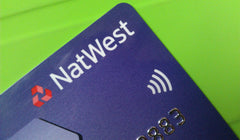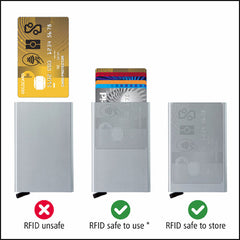Your Cart is Empty
Wallets
Phone Cases
Shop By
What is RFID and NFC? Everything you need to know
June 01, 2015 6 min read 0 Comments

Something we talk about a lot in regards to wallets is RFID protection, also referred to as NFC. Some may nod their heads sagely and know exactly what we're talking about, but the majority may never have heard of this, or at least be a little unsure of what it means, and if they should be worried about it. The short answer to that is, don't be making yourself any tin-foil hats just yet, but you should definitely be aware of what it is, and the potential pitfalls.
It is high time we tackled this subject and made it very easy to understand exactly what RFID means, and if you should care or not. To keep it simple and clear, we've decided to do it in a Q&A format.
WHAT DOES RFID AND NFC STAND FOR?
- RFID: Radio Frequency Identification
- NFC: Near Field Communication
WHAT IS THE DIFFERENCE BETWEEN RFID AND NFC?
Put simply, RFID is a process by which items, such as a credit card, communicate using radio waves. NFC is a specialized subset within the family of RFID technology. Specifically, NFC is a High Frequency branch of RFID. As such, for the average Joe like me and you, the difference isn't all that important. For simplicity's sake, we will refer to the technology as RFID for the rest of this article, safe in the knowledge that NFC falls within that bracket.
If you are particularly interested in learning more about the technical differences between the two, RFID Insider have put together an excellent RFID vs. NFC article and infographic.
What does RFID do?
RFID technology allows an object like a card or phone to communicate simply by touch with a reader. You've likely used this before in the form of a transport card such as Oyster in London, or perhaps even a work access card. Most new credit/debit cards as well as high-end phones have this technology built in.
This allows the payment of small amounts (up to £20 in the UK rising to £30 later this year, and $25 in the US) by simply tapping the card onto a contactless reader which are becoming more and more common, especially in larger cities.
The idea of this is to make everyday purchases simpler, removing the need for a PIN or signature, speeding up transactions and reducing queue times. All good so far right - let's face it, who wouldn't welcome a shorter queue for their morning coffee or lunchtime snack.
How do I know if my card is RFID/Contactless enabled?
 All contactless cards should display the contactless wave symbol, as pictured on the card here. If your card has this, it is RFID enabled, and you can use it for contactless payments anywhere you see the same symbol at a payment point. The vast majority of cards issued in the last 18 months have RFID technology.
All contactless cards should display the contactless wave symbol, as pictured on the card here. If your card has this, it is RFID enabled, and you can use it for contactless payments anywhere you see the same symbol at a payment point. The vast majority of cards issued in the last 18 months have RFID technology.
What is there to worry about?
It all sounds great so far, right? And to be fair I think it is - it makes small purchase simpler, quicker and easier. Some people hear that their cards can be used without the need for any PIN or signature and get understandably anxious, but I would point out that contactless RFID payment is more secure than cash.
However, like pretty much all good or new technology, there are a few potential pitfalls, and always some nasty people looking to exploit it for ill means. There are some things that can catch people out with contactless RFID cards that you should be aware of, (we'll cover ways to avoid them in the next section):
1. Card Theft: If someone steals your card, they don't need to know your PIN to be able to use it.
2. Card Clash: This is where you have more than one contactless card close together, such as in a wallet or purse, when paying, and two cards are charged instead of one. This means you essentially end up paying double.
3. RFID Theft, or "Skimming": It is possible for thieves to use small devices that will scan your card, exploiting the contactless technology take information from it, which can then be used to make copycat cards or other ways of accessing money. It is unknown exactly how common this practice is, but is thought to be on the rise as contactless becomes more common, and the devices used to do it become cheaper.

What steps can you take to secure your cards
It is certainly not time to reach for the scissors and cut the RFID chip out of your card, as this hilariously scare-mongering Fox news report suggests. RFID is incredibly handy and appears to increasingly be the future of small transactions - so if you haven't already, you're going to want to get used to it, it's sticking around. RFID is actually quite secure as information is encrypted, but as with anything to do with personal and financial data, there are a few steps you should take to secure yourself against criminals. Specifically in response to the issues with RFID as laid out above, these steps are:
1. Card Theft: There have always been people wanting to steal cards, nothing new here, so nothing too much to do. Simply be careful about where you store them, and don't leave them lying around. Having a decent wallet should prevent them sliding out of your pocket or bag without you noticing.
If your card was to be stolen, you can rest safe in the knowledge that the thief would be able to spend a limited amount due to the cap on contactless payments, and card providers have systems in place to stop cards being used when irregular patterns are noticed. The chances of a thief running up a large bill before you, or your bank, cancelled your card is slim, and less likely than you simply losing the equivalent in cash.
 2. Card Clash: There are a couple of simple solutions to this. The first is to just think about how and where you store your cards, and be mindful of this when using them to pay. If you store more than one in a wallet, remove your card from the wallet when paying.
2. Card Clash: There are a couple of simple solutions to this. The first is to just think about how and where you store your cards, and be mindful of this when using them to pay. If you store more than one in a wallet, remove your card from the wallet when paying.
Another good idea is to get a wallet that will help you do this, such as aSECRID, which blocks RFID frequencies, unless your card is partially or wholly ejected from the case using the slide mechanism, as shown in the image.
3. RFID Theft, or "Skimming": Storing your cards in a wallet that prevents RFID theft is a foolproof way of preventing this. When inside a RFID protected wallet, it is impossible for anyone to access the data on your card via RFID.
By following these simple methods, it is possible to enjoy all the benefits RFID brings, without needing to worry.
How can a wallet help protect from RFID?
Many wallets on the market now offer some sort of RFID protection. This varies from wallet to wallet, but in general they work by blocking the frequency used to access the data, thus securing your card. Some have nifty features where they allow some degree of protection, whilst allowing you to use cards in a separate sections or pocket.
In general, if a wallet has RFID protection, it well be obviously communicated as it is something that people are increasingly looking for. A couple of our favourites are the SECRID range, and the Metal SLIM wallets.
At the same time however, there are many who prefer the ease of a wallet that does not block RFID signals, so they do not even need to remove their card from the wallet when paying, which is super handy too. It is a personal choice as to how risk averse you are and how convinient you like your payments to be, but the likelihood is there will be a wallet out there that suits you individual style on it.
So there you have it, our comprehensive run down of what RFID/NFC is, why it is useful and what you should know about, and do to protect yourself from theft. Hopefully this has helped you and will aid you in making an informed wallet purchase. You can check out our range of excellent wallets in the Slim Wallet Junkie Store.
Also in News & Reviews
Best Wallets For Working Out And Fitness
July 22, 2020 2 min read 0 Comments

Times have definitely changed and we are all spending more of our time at home. So what essentials do you take with you on your daily exercise walk, run or bike ride? We’ve selected our favourite and best slim wallets which will come in so handy right now, helping you to stay organised, pay contactless if popping into a local shop and helping you to keep all your cards secure whilst you workout.
How well do you know the Secrid range of slim wallets?
July 22, 2020 0 min read 0 Comments

How well do you know the SECRID range of slim wallets? Take this quiz and find out.
A Notebook Like No Other
March 16, 2020 2 min read 0 Comments

Far from being just an ordinary notebook cover, the Bellroy cover is one that has many functions to help you stay as organised as possible from work to weekend, commute to vacation, home to hobby and everything in between!
Subscribe
Sign up to get the latest on sales, new releases and more …

































